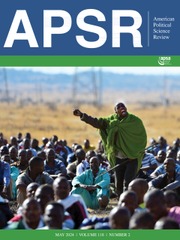Crossref Citations
This article has been cited by the following publications. This list is generated based on data provided by Crossref.
Simon, Herbert A.
1985.
Human Nature in Politics: The Dialogue of Psychology with Political Science.
American Political Science Review,
Vol. 79,
Issue. 2,
p.
293.
WILSFORD, DAVID
1985.
The Conjoncture of Ideas and Interests.
Comparative Political Studies,
Vol. 18,
Issue. 3,
p.
357.
McGuire, Robert A.
and
Ohsfeldt, Robert L.
1986.
An Economic Model of Voting Behaviour over Specific Issues at the Constitutional Convention of 1787.
The Journal of Economic History,
Vol. 46,
Issue. 1,
p.
79.
McLean, Iain
1986.
Some Recent Work in Public Choice.
British Journal of Political Science,
Vol. 16,
Issue. 3,
p.
377.
Utter, Glenn
1987.
OBSERVATION, GENERALIZATION, AND THE CONCEPTUAL IN SOCIAL AND POLITICAL SCIENCE.
Southeastern Political Review,
Vol. 15,
Issue. 1,
p.
3.
Feld, Scott L.
and
Grofman, Bernard
1988.
Majority rule outcomes and the structure of debate in one-issue-at-a-time decision-making.
Public Choice,
Vol. 59,
Issue. 3,
p.
239.
Jervis, Robert
1988.
Realism, Game Theory, and Cooperation.
World Politics,
Vol. 40,
Issue. 3,
p.
317.
Maoz, Zeev
1990.
Framing the National Interest: The Manipulation of Foreign Policy Decisions in Group Settings.
World Politics,
Vol. 43,
Issue. 1,
p.
77.
Lau, Richard R.
Smith, Richard A.
and
Fiske, Susan T.
1991.
Political Beliefs, Policy Interpretations, and Political Persuasion.
The Journal of Politics,
Vol. 53,
Issue. 3,
p.
644.
Jenkins-Smith, Hank C.
1991.
Alternative Theories of the Policy Process: Reflections on Research Strategy for the Study of Nuclear Waste Policy.
PS: Political Science & Politics,
Vol. 24,
Issue. 2,
p.
157.
Jenkins-Smith, Hank C.
1991.
Alternative Theories of the Policy Process: Reflections on Research Strategy for the Study of Nuclear Waste Policy.
PS: Political Science & Politics,
Vol. 24,
Issue. 2,
p.
157.
Dryzek, John S.
1992.
How Far is it from Virginia and Rochester to Frankfurt? Public Choice as Critical Theory.
British Journal of Political Science,
Vol. 22,
Issue. 4,
p.
397.
McLean, Iain
and
Urken, Arnold B.
1992.
Did Jefferson or Madison understand Condorcet's theory of social choice?.
Public Choice,
Vol. 73,
Issue. 4,
p.
445.
Engstrom, Richard L.
and
McDonald, Michael D.
1993.
‘Enhancing’ factors in at-large plurality and majority systems: A reconsideration.
Electoral Studies,
Vol. 12,
Issue. 4,
p.
385.
Jones, Bryan D.
Baumgartner, Frank R.
and
Talbert, Jeffery C.
1993.
The Destruction of Issue Monopolies in Congress.
American Political Science Review,
Vol. 87,
Issue. 3,
p.
657.
Nagel, Jack H.
1993.
Populism, Heresthetics and Political Stability: Richard Seddon and the Art of Majority Rule.
British Journal of Political Science,
Vol. 23,
Issue. 2,
p.
139.
ANTHONY, DENISE L.
HECKATHORN, DOUGLAS D.
and
MASER, STEVEN M.
1994.
Rational Rhetoric in Politics.
Rationality and Society,
Vol. 6,
Issue. 4,
p.
489.
Poole, Keith T.
and
Smith, Richard A.
1994.
A spatial analysis of winning and losing motions in the U.S. Senate 1979?1981.
Public Choice,
Vol. 78,
Issue. 1,
p.
23.
Savage, James D.
1994.
Corruption and Virtue at the Constitutional Convention.
The Journal of Politics,
Vol. 56,
Issue. 1,
p.
174.
Weale, Albert
1995.
William Riker and the theory of democracy.
Democratization,
Vol. 2,
Issue. 3,
p.
377.


Comments
No Comments have been published for this article.